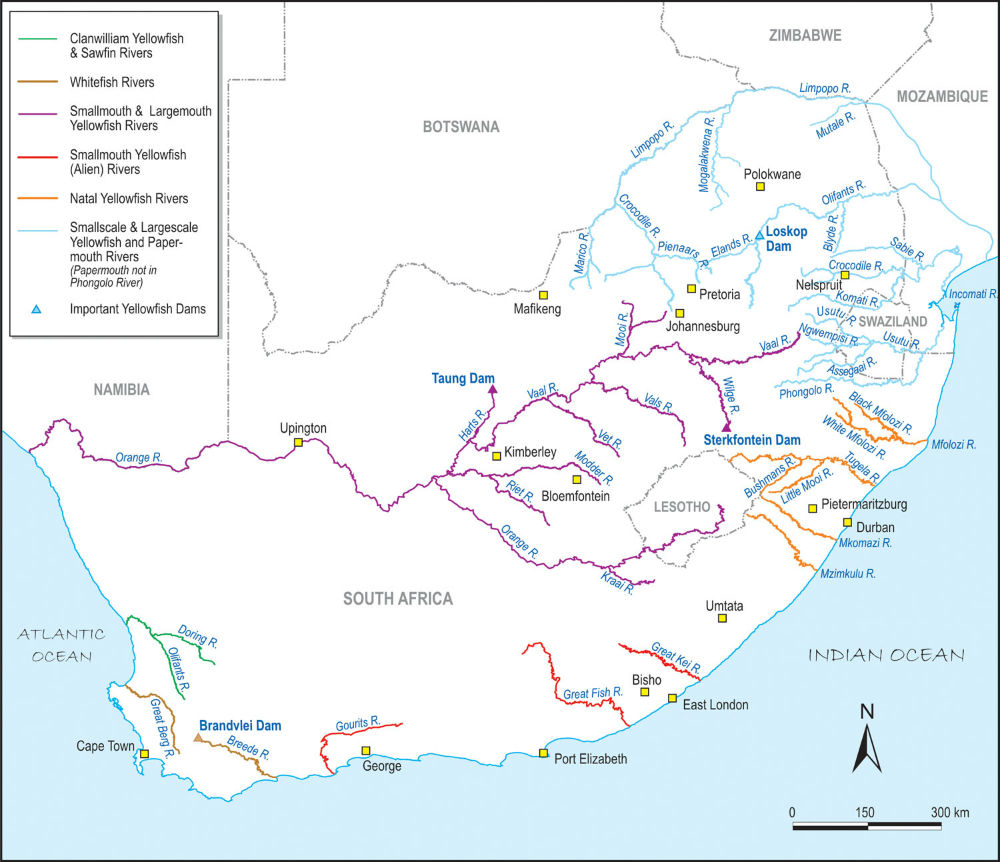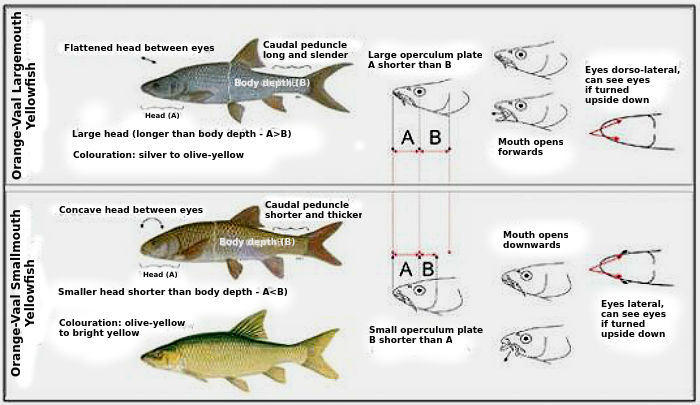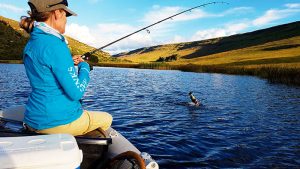If you’re like us you have at some point caught a yellowfish and wondered which of the 7 different species it is. Not to mention the 3 similar species that add to the confusion. Searching online helped a lot but the info can be overwhelming and confusing sometimes.
In this post, we will attempt to simplify the identification of yellowfish in South Africa by aggregating all the info we could find into one easy guide.
Background info
1. Yellowfish species that occur in South Africa
2. Similar species that occur in South Africa
3. Map of yellowfish distribution in South Africa
Identification
1. Where was it caught?
2. What’s the difference between a smallmouth and a largemouth yellowfish?
3. What’s the difference between a smallscale and a largescale yellowfish?
4. Other?
Background info
Let’s start with a very brief overview of all yellowfish that roam South African waters.
1. Yellowfish species that occur in South Africa
There are only 7 true yellowfish (Labeobarbus) that occur in South Africa. Here they are sorted by most commonly fished:
| Name | Other Name\s | Location | Max Size \ Length | SA record | Photos |
|---|---|---|---|---|---|
| Smallmouth Yellowfish (Labeobarbus aeneus) | Orange\Vaal River system (including Sterkfontein Dam), Gouritz (WC), Kei (EC), Great Fish (EC), Limpopo (LP), Pongola (MP) Rivers | 7kg \ 50cm | 7.8kg | ||
| Largemouth Yellowfish (Labeobarbus kimberleyensis) | Orange\Vaal River system (including Sterkfontein Dam) | 22kg \ 100cm | 9.5kg | ||
| Bushveld Smallscale Yellowfish (Labeobarbus polylepis) | Limpopo, Elands, Crocodile, Komati, Pongola Rivers, basically north and east of South Africa | 6.8kg \ 46cm | 6.1kg | ||
| Lowveld Largescale Yellowfish (Labeobarbus marequensis) | Limpopo, Elands, Crocodile, Komati, Pongola Rivers, basically north and east of South Africa | 6kg \ 47cm | 5.7kg | ||
| Kwazulu-Natal Yellowfish (Labeobarbus natalensis) | Scaly Yellowfish | Throughout KZN from the Mkuze River in the north to the Mtamvuna River in the south | 4kg \ 70cm | 4.6kg | |
| Clanwilliam Yellowfish (Labeobarbus capensis) | Olifants\Doring River system (WC) | 10.6kg \ 98cm | 5.6kg | ||
| Incomati Chiselmouth (Labeobarbus nelspruitensis) (since 2015) | Horingbek | Komati, Pongola, Sabie River systems (MP) |
2. Similar species that occur in South Africa
Another 3 species are related and similar to yellowfish but not classified as such:
| Name | Other Name\s | Location | Max Size \ Length | SA record | Photos |
|---|---|---|---|---|---|
| Berg\Breede River Whitefish (Barbus andrewi) | Witvis | Berg\Breede River system (WC) | 7kg \ 80cm | 3.4kg | |
| Bushveld Papermouth (Barbus rapax) | Limpopo, Elands, Crocodile, Komati, Pongola Rivers, basically north and east of South Africa | 1.3kg \ 20cm | 1.3kg | ||
| Clanwilliam Sawfin (Barbus serra) | Olifants\Doring River system (WC) | 3kg \ 60cm | 3kg |
3. Map of yellowfish distribution in south africa
We found this fantastic map on the Federation of South African Flyfishers site and it clearly illustrates where all the different yellowfish can be found.

Identification
Ok fine, but how do I identify my yellowfish? Well after spending some time trawling through forums etc. we found by asking the following questions we can easily distinguish between the different types of yellowfish.
1. Where was it caught?
Just looking at the table and map above it’s clear that we can discard quite a few species by just determining where it was caught.
So here goes:
| Where was it caught? | Possible type of yellowfish |
|---|---|
| Vaal, Orange Rivers | can almost only be a Smallmouth or Largemouth |
| Limpopo, Pongola, Sabie, Komati etc. Rivers (northeast of SA) | almost certainly a Bushveld Smallscale or Lowveld Largescale, but can also be a Smallmouth, a Papermouth or even an Incomati Chiselmouth |
| Smaller rivers in KZN flowing to the Indian ocean | can only be a Kwazulu-Natal Yellowfish |
| Kei, Gouritz, Great Fish Rivers | can only be a Smallmouth |
| Berg, Breede Rivers in WC | definitely a WhiteFish |
| Olifants, Doring Rivers in WC | either a Clanwilliam Yellowfish or Sawfin |
Ok, with that out the way let’s differentiate between yellowfish that occur in certain bodies of water together.
2. What’s the difference between smallmouth and a largemouth yellowfish?
We’ve found there are two main ways of differentiating between these two common yellowfish:
a. Location of the eyes
Basically, turn your yellowfish on its back, and then try to see its eyes from the bottom. If you can see its eyes protruding on the sides of its head then it’s a smallmouth. If you can’t see the eyes it’s probably a largemouth.
This is because the smallmouth yellowfish is predominantly a bottom feeder and needs to see food below it. Conversely, the largemouth is predominantly a hunter and generally looks upwards to spot prey.
b. Shape of mouth
Gently press the bottom lip of the yellowfish down. If the mouth opens downwards it’s a smallmouth. And if its mouth opens mostly forwards it’s a largemouth.
This is because of the same reasons as above.
c. Still can’t determine the type of yellowfish?
Finally, have a look at the following detailed graphic. We found it lying around in a forum and took the liberty of enhancing it to be more readable. This will surely settle any further debate 🙂

3. What’s the difference between a smallscale and a largescale yellowfish?
This one’s a bit easier and it’s all around counting the number of scales they have (obviously) and some other characteristics.
a. Lateral line scale count
Largescale yellowfish generally have around 27-33 scales in the lateral line. Whereas smallscales have around 36-44 scales in the lateral line.
b. Uppermost scale count
You can also count the number of scales from the head to the dorsal fin (uppermost scales). The largescale has around 8-9 scales. And the smallscale more than 10.
c. Fin color
The largescale normally has bright orange fins, whereas smallscale has a blueish tinge to its fins.
d. Body shape
Largescales are normally bulkier than smallscale which has a more streamlined body.
NOTE: please try not to keep the fish too long out of water while counting scales, rather take a photo and do the counting later
4. Other?
For other types of yellowfish that inhabit the same bodies of water, we couldn’t find any resources. For example the difference between smallmouth yellowfish, papermouth, and smallscale. Also, what are the differences between the Clanwilliam yellowfish and a sawfin?
We’ll continue looking for any info regarding those questions, and we’ll be adding many more photos of these fish to simplify identification…
But in the meantime, if you have anything to add to our research that would be great. Please comment below or send us an email if you find any errors or have any further useful info we could use.
References \ further reading
Special thanks must go out to these sites\organisations which we gathered all our info from. They have put in a lot of effort to compile comprehensive detail of each type of yellowfish. Click on the links below to find out more about this fascinating fish.
Federation of South African Flyfishers
FishBase
yellowfish.co.za



